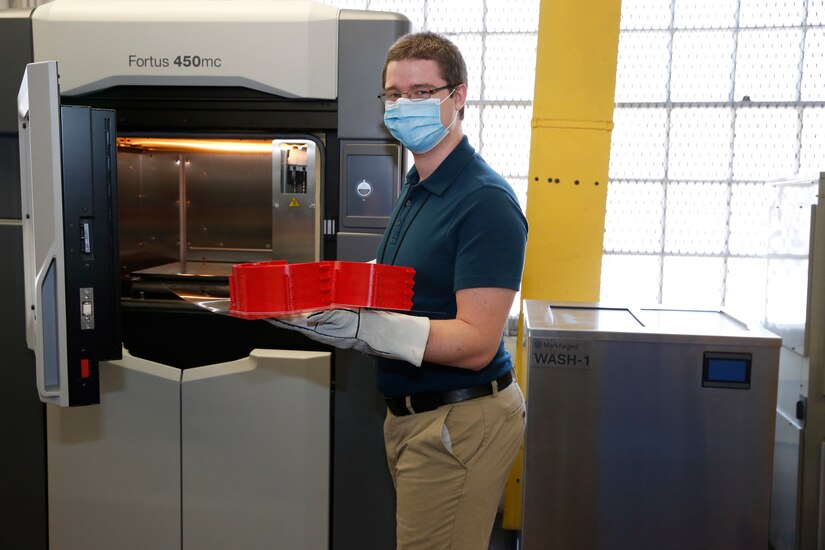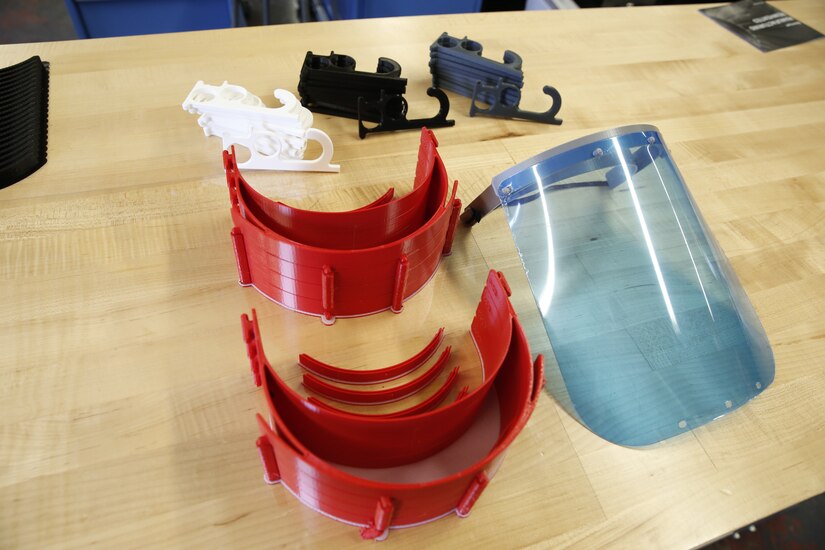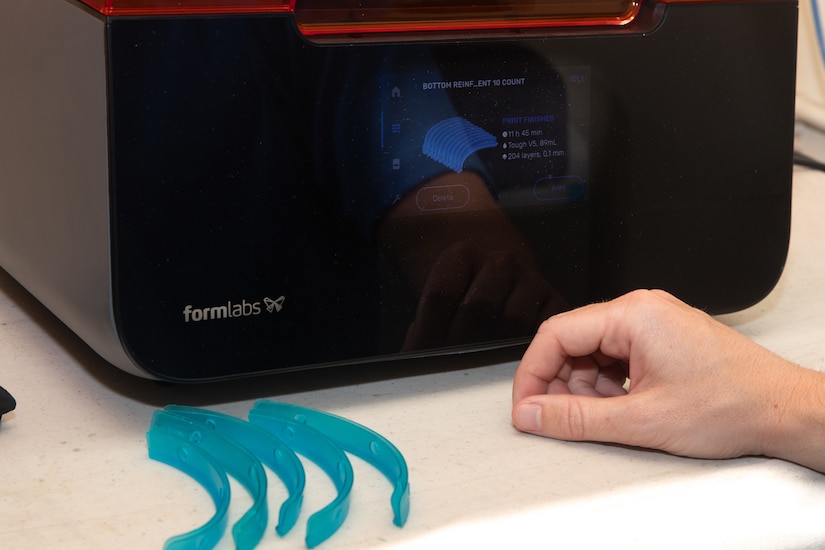In Mid-March, Naval Sea Systems Command reached out to innovation programs at its shipyards and other departments acto assess additive manufacturing capability to produce personal protective equipment so workers could safely maneuver through the current environment.
Simultaneously, requests began pouring in from individuals across the shipyard with a strong desire to assist in the development and production efforts.

''It was a developing situation with COVID-19, and the growing concern for the need of PPE to continue daily service,'' said Dale Berkley, the Norfolk Naval Shipyard's technology insertion manager. ''We saw the need and began gauging each of the shipyard's [additive manufacturing] labs to scope their availability, capacity and material inventory. It became a group effort to answer the call, and we began formalizing printing at the end of March.''
The face shields are composed of four parts: a headband to hold a clear plastic shield, an elastic strap and a reinforcement clip at the bottom to strengthen the plastic's curve. The technology and innovation lab joined with additive manufacturing labs across the shipyard — including the Nuclear Mechanical Group, Non-Nuclear Mechanical Group, Non-Nuclear Inspection Division , Carrier Programs, Radiological Engineering Division and Nuclear Special Emphasis Division — to begin researching designs approved by the National Institutes of Health.
With alignment on a single approved design for the face shields, the labs hit the ground running, printing the headbands and reinforcement clips using desktop, industrial and resin 3D printers. The Nuclear Fluid Systems and Mechanical Engineering Division and the shipyard's technology and innovations lab handled printer material orders to ensure the teams had what they needed to get the job done as quickly as possible. Finally, once the clips and headbands were completed, they were turned over to the Production Resource Department, Facilities Department, Pipefitting Group and the SIOP Program Management Office for development of the plastic shields, finalizing assembly and distributing them across the shipyard, as well as to local partners.

''As a team, we were able to take these designs and iron out the printing and assembly process, testing and perfecting it, so that we were able to make these masks as quickly as possible,'' said Kyle Cooper, the coordinator of nuclear continuous training and development. ''It's been a learning experience for everyone. We were able to cut down the printing of headbands themselves down to 57 minutes, which initially was three and a half hours. It came down to trial and error, sharing our input and working towards making the best product possible.''
''This is a true testament to the teamwork here at NNSY, everyone coming together to provide their input and services with a common goal in mind,'' said Jessica Roberts, the NNSY Technology and Innovation Community of Practice lead and the Additive Manufacturing Subcommittee lead. ''It was a challenge we hadn't really faced before, to this degree, as this was the first time all the AM labs across the shipyard had come together for a single project. So many departments needed to be aligned and understand each other's abilities and what they would be bringing to the table. It was an evolving process and communication was key to ensure everything went as smoothly as possible.''
The Non-Nuclear Inspection Division's Adam and Joel Seamster used their large-capacity additive manufacturing lab, composed of more than 20 desktop printers, to mass-produce headbands and clips. They helped ensure the technical aspect of the job was handled, working with the various labs to optimize the selected design for quicker and more cost effective printing, as well as testing materials for the best quality.
James Keim, with the technology and innovation lab, noted that working together for a common goal to protect their fellow shipyarders was a great experience.

''While the waterfront was working to adapt to the new constraints created by COVID-19, the Innovation Program wanted to find ways to alleviate that burden and prevent it from getting worse,” Keim said. “When it was evident that PPE was becoming scarce, it was clear that it was an immediate action we could take. We did not want to wait for the requests to come in because, by then, it would be too late. It made more sense to us to be ready with a stockpile for when the need hit.
“As for starting the process,'' he continued, ''we looked to what other groups had started. Since Virginia was not hit as hard, as fast as other states, we were able to make use of other's experience to make ours smoother. The National Institutes of Health had actually started a collection of PPE designs that they approved. We chose one as a starting point and adjusted our print parameters and materials until we came up with a print package that worked best for us.
It truly was a team effort,'' Keim said.
''There was a ton of eagerness across the board to get started and assist,'' he said. ''We have many in the AM community with varied experience. When we were optimizing our prints, we made sure any improvements we found went out to all the other labs so they could try them. As material shortages hit us, we got together to prioritize where our resources went to make sure we had the highest production possible.''
Carrier Programs had been pursuing efforts in AM for quite some time to quickly design and prototype tooling required to complete special emphasis work, said Daniel Miller, a nuclear engineer. ''When there was a call to action, we were there to assist,'' he added.

Carrier Programs worked closely with the Radiological Engineering and mechanical engineering Divisions. We were able to break down everyone's role and responsibility and learn from one-another, Miller said.
''This was a partnership that provided a resource stream of this vital equipment for our community,'' said Jason Markle the Program Management Office integrator. ''We were able to maintain a flow of fabrication materials, inventory levels, while coordinating storage, distribution and supply lines. Each code and each team member had a part to play to ensure the success of the mission.''
Markle said that in addition to providing PPE to the shipyard at large, the team was able to deliver two batches of face shields to the Portsmouth Naval Hospital for testing and use. ''This effort readied NNSY to be called upon to lend our aid for equipment supply to those who need it in the community at large,'' he said.
(Kristi R. Britt is assigned to the Norfolk Naval Shipyard.)






No comments:
Post a Comment